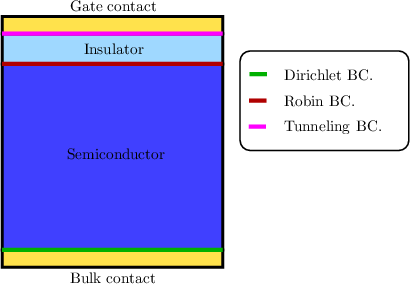4.5 Boundary Conditions
There are at least three possible choices of boundary conditions. Systematic research was, for example,
conducted in this area by [9, 90], where all kinds of conditions, such as
| γ = f | Dirichlet, | (4.25)
|
 = f = f | von Neumann and | (4.26)
|
αγ + β = f = f | Robin | (4.27) |
boundary conditions have been tested, where d is the normal vector of the oxide semiconductor
interface, α, β and f need to be reasonably chosen. At the boundaries of the device or
semiconductor segments which do not border to an insulator segment Dirichlet conditions with
γn = γp = 0, have always been employed throughout the literature. Whereas various types of
boundary conditions at semiconductor-insulator interfaces have been tested, including
Dirichlet, von Neuman and Robin conditions. It is necessary to find boundary conditions for
semiconductor-insulator interfaces with which it is possible to correct the electrostatic
potential such, that the carrier concentrations calculated by the transport model yield the
same as predicted by the Schrödinger equation (cf. Section 2.6). It was shown that Robin
boundary conditions prove to be the best choice at semiconductor-insulator interfaces,
since they allow the best fit with the carrier concentration obtained from a solution of the
Schrödinger equation [90]. Subsequently Robin boundary conditions at semiconductor-insulator
interfaces for Equation (4.2) are used throughout this thesis (cf. Figure 4.2). However, it was
found on [91] that upon solving Equation (4.2) for insulator segments too, it has been
suggested that it is possible to assess direct tunneling. Nevertheless, in the course of this
thesis this feature of the DG model was not used since a more powerful technique, namely
NEGF, is available to assess direct tunneling currents through oxides in MOS structures.
 = f
= f = f
= f = f
= f = f
= f